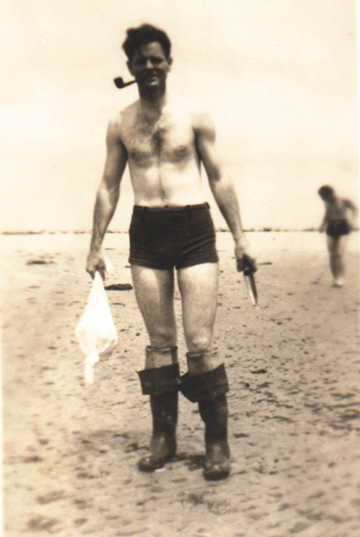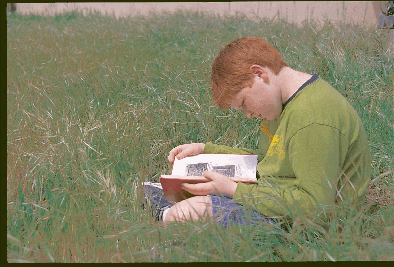|
Related Articles:
Conversations
with a tide pool | Through
a fissure

Monterey Memory
By Joan Hewitt Swaim '56

Lives
of great men all remind us
We can make our lives sublime,
And, departing, leave behind us
Footprints on the sands of time;
Footprints,
that perhaps another,
Sailing o'er life's solemn main,
A forlorn and shipwrecked brother,
Seeing, shall take heart again.
Henry
Wadsworth Longfellow
 Willis
Hewatt, hereinafter known as "Daddy," loved poetry. Many an
evening in our home on Rogers Road, with homework done and without the
option of television, my sister and I would snuggle up beside him on our
living room couch and listen to him read from the several books of poetry
on our shelves. His selections ranged from William Wordsworth and Rudyard
Kipling to Robert W. Service, Edgar Allan Poe, and Oliver Wendell Holmes.
His reading of Holmes' The Chambered Nautilus will be remembered by all
who sat in his invertebrate zoology classes. Willis
Hewatt, hereinafter known as "Daddy," loved poetry. Many an
evening in our home on Rogers Road, with homework done and without the
option of television, my sister and I would snuggle up beside him on our
living room couch and listen to him read from the several books of poetry
on our shelves. His selections ranged from William Wordsworth and Rudyard
Kipling to Robert W. Service, Edgar Allan Poe, and Oliver Wendell Holmes.
His reading of Holmes' The Chambered Nautilus will be remembered by all
who sat in his invertebrate zoology classes.
One of Daddy's
favorite poems was Henry Wadsworth Longfellow's Psalm of Life. I recall
him reading it to my sister and me when we really weren't old enough to
understand its message, much less appreciate it. "╔Bivouac of Life╔,"
"be a hero in the strife╔," "Life is real! Life is earnest!/
And the grave is not its goal;/ Dust thou art, to dust returneth,/ Was
not spoken of the soul╔" etc., etc., wafted rhythmically into our
ears and above our heads. But the stanza that reads, "Lives of great
men all remind us/ We can make our lives sublime,/ And, departing, leave
behind us/ Footprints on the sands of time/" always made me envision
footprints on a wet sandy beach, and I could certainly relate to that.
The sea and seashore with its myriad animal and plant secrets were revealed
to me from very early childhood, and at every opportunity Daddy's first
love of marine biology would find us seaside, searching among riprap,
tide pools and pilings for whatever moved or could be defined as living.
Daddy's cadence
intensified as he read those Longfellow lines, punctuating their importance.
Those words and his voice still ring in my head. And, as it turns out,
Daddy not only left his "footprints" on the "sands of time," but someone
searching for them 60 years later actually found them, stepped into and
followed them to a destination that may have far-reaching implications
for how we manage our planet for sustainable life. The story of the discovery
of the brass "footprints" and the intertidal "time" trail he left, and
how that all came about, is a fascinating one centering around three extraordinary
scientists, each approaching the subject from slightly differing aspects.
Although
he ended up a landlocked scientist in Fort Worth, Daddy's passion was
the sea world of invertebrate life. How he discovered this passion is
shrouded in the mist of Monterey, California. He grew to manhood entirely
in the Fort Worth area, the fourth of five children. His mother was widowed
before the fifth was born. I'm not sure that he ever was near the sea
before he left TCU in 1931 to pursue his doctorate at Stanford University.
I never questioned why he chose the marine scene. That was always who
he was -- a professor of biology at TCU during regular semesters and a specialist
in marine biology on various coasts during the summers. No one I have
queried from that period seems to have the answer, either. My guess is
that he was "sent to" (read "placed at") Stanford by Mr. Will Winton,
his mentor at TCU, and, once there, fell in love with the coast and opted
for study at Stanford's Hopkins Marine Station at Pacific Grove on the
Monterey peninsula, in turn falling in love with the beauty of the salt-water
"beasts," as he called them.
That he did
his study on the protected shoreline of Hopkins can simply be explained
by the fact that he had no conveyance to, or equipment for, another location.
I think he felt very fortunate to even be able to attend graduate school
in the middle of the Depression. I have a poignant letter from him to
his mother while at Pacific Grove, lamenting that he could not help more
with her finances and those of his own new family of wife and expected
first child. He seemed to be barely able to subsist. Speculation could
continue -- but seems, in my view, unimportant here.
 It
was not until the spring of 2001, that I heard of a young Stanford University
doctoral candidate, Rafe Sagarin, who had replicated Daddy's 1931-33 research
at Cabrillo Point in Monterey Bay. It was as if Daddy was suddenly standing
in the doorway. So unexpected -- so strange to have him materialize in
this way. I knew then that I would have to go meet the men who knew my
father in an altogether different way than most who recall his memory
to me. Rafe and his mentor, Charles Baxter, who had suggested repeating
the earlier research, knew his intellect and work. They had only a far-off
snapshot of him in black and white. On my side, I had scanned his dissertation
once and knew that it spoke to the adventures of the little homing limpet
of the West Coast, Acmaea Scabra. I had no idea of the extent of the entire
study. I wanted to "touch" this connection. It
was not until the spring of 2001, that I heard of a young Stanford University
doctoral candidate, Rafe Sagarin, who had replicated Daddy's 1931-33 research
at Cabrillo Point in Monterey Bay. It was as if Daddy was suddenly standing
in the doorway. So unexpected -- so strange to have him materialize in
this way. I knew then that I would have to go meet the men who knew my
father in an altogether different way than most who recall his memory
to me. Rafe and his mentor, Charles Baxter, who had suggested repeating
the earlier research, knew his intellect and work. They had only a far-off
snapshot of him in black and white. On my side, I had scanned his dissertation
once and knew that it spoke to the adventures of the little homing limpet
of the West Coast, Acmaea Scabra. I had no idea of the extent of the entire
study. I wanted to "touch" this connection.
Ironically,
these men had tried to connect, also, at the time of the 1992 study, only
to find to their great disappointment that Daddy had died in 1980. Again,
ironically, they found my Web site, but it had no addresses, and queries
directed to TCU on my whereabouts went unanswered. Then, my cousin, Dale
Gilliland, who lives in Southern California, heard of Rafe's study on
the Jim Lehrer News Hour, contacted The TCU Magazine, which contacted
me, and, as they say, thereby hangs the tale.
 My
daughter Susie, grandson Asher and I made the trip to Pacific Grove/Monterey
this past Easter to grasp yet another shoot of our roots. It was good
to sit with all those connections on the promontory above the bay and
talk the talk of the marine natural world with Chuck Baxter and Rafe Sagarin.
Their words I had heard many, many times and many years ago in similar
settings. I had danced happily to that rhythm before. My
daughter Susie, grandson Asher and I made the trip to Pacific Grove/Monterey
this past Easter to grasp yet another shoot of our roots. It was good
to sit with all those connections on the promontory above the bay and
talk the talk of the marine natural world with Chuck Baxter and Rafe Sagarin.
Their words I had heard many, many times and many years ago in similar
settings. I had danced happily to that rhythm before.
Daddy was
good, but he wasn't prescient. His work was about the ecological makeup
of an intertidal transect off Cabrillo Point; global warming was a concern
off in the future. Then, from the 1970s, Charles Baxter watched Cabrillo
Point as its flora and fauna changed, and he grew suspicious of its cause.
At Chuck's suggestion and armed with the 1933 Hewatt guidelines, Rafe
Sagarin took up the baton and waded, literally, into the issue of global
warming and what it might mean for the natural world in which we live -- three
generations reaching across the years, helping, in their combined efforts,
to find our way.
There is
a kind of poesy there, methinks, that could fit right in with "heroes
in the strife." I know Willis Gilliland Hewatt would have thought so.

Joan Hewatt Swaim '56 is author of Walking TCU: A Historical Perspective.
She retired in 1995 as coordinator of bibliographic control for the Mary
Couts Burnett Library after 18 years. Read more at www.joanhewattswaim.com,
and contact her at Jhewattswaim@aol.com.
Top
|



